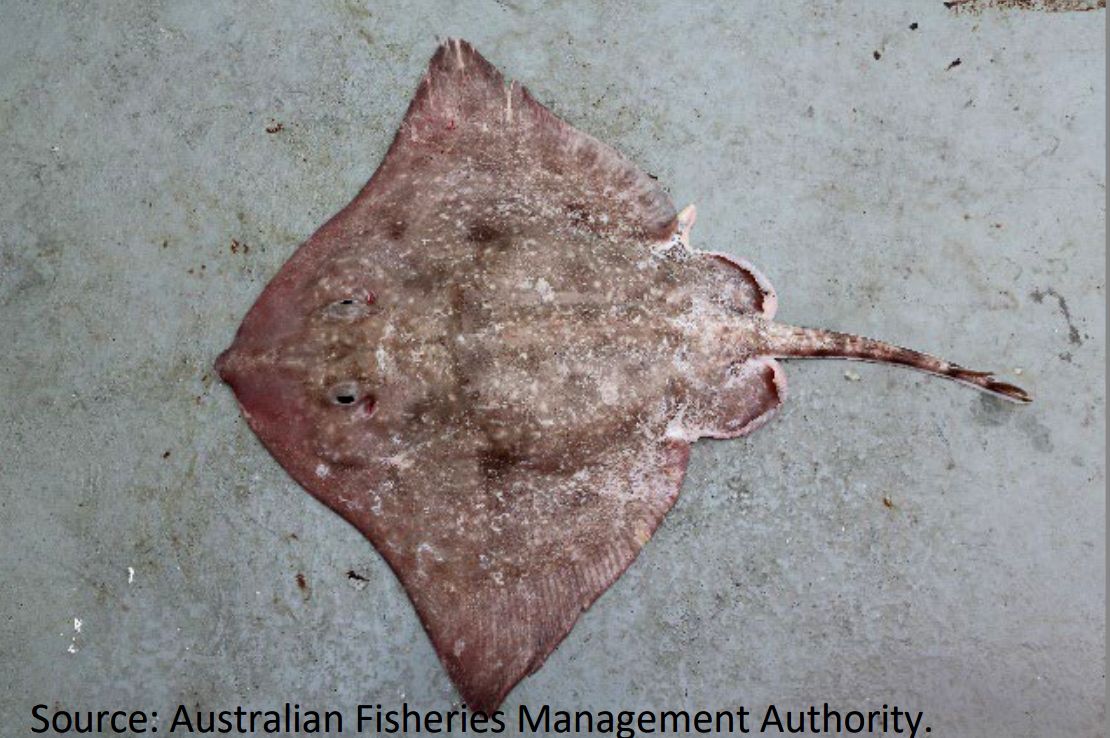Whiteleg Skate, Amblyraja taaf (Meisner 1987)

Amblyraja taaf, from Australia's Heard and McDonald Islands territory. Source: Australian Fisheries Management Authority (AFMA). License: All rights reserved
Summary:
A greyish-brown skate with more or less distinct dark blotches sometimes mixed with pale spots (but without pseudo-ocelli), and contrasting white anterior pelvic lobes sometimes with a few dark spots. Rare individuals may be overall dark with pale margins.
Cite this page as:
Bray, D.J. 2024, Amblyraja taaf in Fishes of Australia, accessed 29 Apr 2024, https://fishesofaustralia.net.au/Home/species/5728
Whiteleg Skate, Amblyraja taaf (Meisner 1987)
More Info
|
Distribution |
Southern Ocean in the Australian territory of Heard and McDonald islands. Elsewhere the species occurs in the Antarctic Indian Ocean in the area off the Crozet Islands, Del Cano Rise, and the Prince Edward and Marion Islands and also in the area of the Kerguelen Plateau and the Elan Bank. The species is demersal on insular shelves and slopes at depths of 150–1,810 m. |
|
Features |
Disc broadly subrhombic, outer corners rather sharply angled. Snout short, obtusely angled, rostral cartilage broad, stiff, inflexible. Mouth very wide, 33-42 tooth rows in upper jaw. Tail solid, depressed, length at most equal to disc length, distinctly shorter in larger specimens. Lateral folds along almost entire length of tail; originating as keels at pelvic axils, widening as narrow folds in posterior half, terminating just before tail tip. Entire upper side of disc very rough with scattered very coarse spinules and additional strong thornlets in half-grown and large specimens; thornlets most concentrated on snout, along anterior disc margins, and from pectoral-fin axils along insertion. Midline of body and sides of tail also with rows of thornlets in larger specimens. Posterior pelvic lobes also rough, with spinules and thornlets; anterior lobes smooth. In mature males, the pectoral centres may be sparsely prickly or almost smooth. Underside of disc, pelvic fins and tail often completely smooth, occasionally with a narrow strip of a few spinules medially on snout tip; large females also have spinules along outer snout margins. Dorsal thorns typically very large, with a distinctly ribbed basal cone and radiated basal plate, set in almost constant arrangement and number. A pair of preorbital, postorbital and supraspiracular thorns, 1 or 2 medially on nape, 1 on midshoulder, 2 or 3 on each shoulder in oblique or triangular arrangement respectively; 20-28 (usually 24-28) in a regular median row from behind shoulder girdle to first dorsal fin, of which 4-6 are on the body to pectoral axils. Occasionally a small thorn between dorsal fins. |
|
Colour |
A mostly medium greyish-brown to chestnut-brown skate, usually patterned with large, circular dark blotches on the entire disc and posterior pelvic lobes, and a white underside. The species has a narrow whitish margin on the posterior pelvic lobes, pale lateral tail folds, and occasionally faint pale blotches on the sides of tail. In most individuals, the upper side of the anterior pelvic lobes is pale, contrasting with the overall dark colour of the dorsal surface. |
|
Feeding |
Feeds mostly on benthic invertebrates and bony fishes. |
|
Biology |
The species is oviparous (egg-laying). Females produce paired egg capsules with horn-like projections. Size-at-birth 17 cm TL. |
|
Fisheries |
Taken as incidental bycatch in longline fisheries that target Patagonian Toothfish in Subantarctic Indian Ocean waters, including around the Heard and McDonald Islands (Australian Territory). |
|
Etymology |
The specific name is an acronym for the type locality, Terres australes et antarctiques françaises (Territory of the French Southern and Antarctic Lands) - a group of volcanic islands in the southwestern Indian Ocean. |
|
Species Citation |
Raja taaf Meisner 1987, Zoologicheskii Zhurnal 66(12):1840, Figs. 1-2. Type locality: Lena Bank, 53°01'S, 44°25'E, southwestern Indian Ocean, depth 390-375 m. |
|
Author |
Bray, D.J. 2024 |
|
Resources |
Whiteleg Skate, Amblyraja taaf (Meisner 1987)
References
Compagno, L.J.V. & Ebert, D.A. 2007. Southern African skate biodiversity and distribution. Environmental Biology of Fishes 80: 125–145. https://doi.org/10.1007/s10641-007-9243-4
Duhamel, G., Gasco, N. & Davaine, P. 2005. Poissons des îles Kerguelen et Crozet. Guide régional de l'océan Austral. Publications Scientifiques du Muséum national d'Histoire naturelle. Paris. 1-419.
Last, P.R., Séret, B., Stehmann, M.F.W. & Weigmann, S. 2016. 19. Skates. Family Rajidae, pp. 204-363 in Last, P.R., White, W.T., Carvalho, M.R. de, Séret, B., Stehmann, M.F.W. & Naylor, G.J.P. (eds). Rays of the World. Clayton South, Victoria : CSIRO Publishing 790 pp.
McEachran, J.D. & Dunn, K.A. 1998. Phylogenetic analysis of skates, a morphologically conservative clade of elasmobranchs (Chondrichthyes: Rajidae). Copeia 1998(2): 271-290 https://doi.org/10.2307/1447424
Meisner, E.E. 1987. Une nouvelle espèce de la raie (Rajidae, Batoidei) du secteur indien de Antarctique. A new species of ray (Rajidae, Batoidei) from the Indian Ocean sector of the Antarctic. Zoologicheskii Zhurnal 66(12): 1840-1849. [In Russian, French summary.]
Pollom, R., Gasco, N., Leslie, R. & Péron, C. 2020. Amblyraja taaf. The IUCN Red List of Threatened Species 2020: e.T161392A124476426. https://dx.doi.org/10.2305/IUCN.UK.2020-2.RLTS.T161392A124476426.en. Accessed on 07 February 2024.
Stehmann, M. & Bürkel, D.L. 1990. Rajidae. pp. 86-97 in Gon, O. & Heemstra, P.C. (eds). 1990. Fishes of the Southern Ocean. Grahamstown : J.L.B. Smith Institute of Ichthyology 462 pp. https://doi.org/10.5962/bhl.title.141868 (as Raja taaf)


